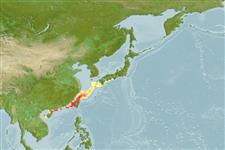>
Anguilliformes (Eels and morays) >
Muraenidae (Moray eels) > Muraeninae
Etymology: Gymnothorax: Greek, gymnos = naked + Greek, thorax, -akos = breast (Ref. 45335).
Environment: milieu / climate zone / depth range / distribution range
Ecología
marino demersal; rango de profundidad 35 - 150 m (Ref. 12958). Subtropical
Northwest Pacific: Taiwan, including the Pescadore Islands (=Penghu).
Tamaño / Peso / Age
Maturity: Lm ? range ? - ? cm
Max length : 88.2 cm TL macho / no sexado; (Ref. 121652); peso máximo publicado: 796.80 g (Ref. 121652)
Dorsal fin moderately high. Anus in front of mid-body point. Body and fins darkish brown, with numerous snowflake-like patches. Skin of pericranium area with many small whitish spots. Corner of mouth blackish. Anal fin margin white, while edge of the dorsal and caudal fins are dark.
Life cycle and mating behavior
Madurez | Reproducción | Puesta | Huevos | Fecundidad | Larva
Chen, H.-M., K.-T. Shao and C.-T. Chen, 1996. A new moray eel, Gymnothorax niphostigmus, (Anguilliformes: Muraenidae) from northern and eastern Taiwan. Zool. Studies 35(1):20-24. (Ref. 12958)
IUCN Red List Status (Ref. 130435)
Threat to humans
Harmless
Human uses
Más información
Nombres comunesSinónimosMetabolismoDespredadoresEcotoxicologíaReproducciónMadurezPuestaAgregación para la puestaFecundidadHuevosEgg development
ReferenciasAcuiculturaPerfil de acuiculturaRazasGenéticaElectrophoresesheritabilidadEnfermedadesProcesamientoNutrientsMass conversion
ColaboradoresImágenesStamps, Coins Misc.SonidosCiguateraVelocidadTipo de nataciónSuperficie branquialOtolitosCerebrosVisión
Herramientas
Special reports
Download XML
Fuentes de Internet
Estimates based on models
Preferred temperature (Ref.
123201): 17.7 - 23.7, mean 21.8 °C (based on 59 cells).
Phylogenetic diversity index (Ref.
82804): PD
50 = 0.5000 [Uniqueness, from 0.5 = low to 2.0 = high].
Bayesian length-weight: a=0.00052 (0.00033 - 0.00085), b=3.24 (3.11 - 3.37), in cm total length, based on LWR estimates for this species & Genus-body shape (Ref.
93245).
Nivel trófico (Ref.
69278): 4.1 ±0.7 se; based on size and trophs of closest relatives
Resiliencia (Ref.
120179): Bajo, población duplicada en un tiempo mínimo de 4.5-14 años (Preliminary K or Fecundity.).
Fishing Vulnerability (Ref.
59153): High vulnerability (55 of 100).
